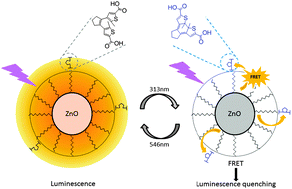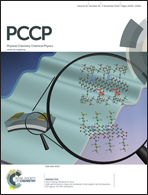Photocontrol of luminescent inorganic nanocrystals via an organic molecular switch†
Abstract
A photo-controlled and quasi-reversible switch of the luminescence of hexadecylamine-coated ZnO nanocrystals (ZnO@HDA Ncs) is operated via a molecular photoswitch (dithienylethene, DTE). The interaction between the DTE switch and the ZnO@HDA Ncs is thoroughly investigated using NMR spectroscopy techniques, including DOSY and NOESY, showing that the DTE switch is weakly adsorbed at the surface of the Ncs through the formation of hydrogen bonds with HDA. Steady state and time-resolved luminescence quenching experiments show a complex behavior, related to the spatial distribution of the emitting defects in the Ncs. Analysis of the data using models previously developed for Ncs supports static quenching. Both isomeric forms (open or closed) of the DTE switch quench the emission of Ncs, the efficiency being more than ten times higher for the closed isomer. The mechanism of quenching is discussed and we show that quenching occurs mainly through resonant energy transfer for the closed isomer and through electron transfer for the open one. The HDA layer mediates the quenching efficiency as only defects located near the surface are quenched.


 Please wait while we load your content...
Please wait while we load your content...